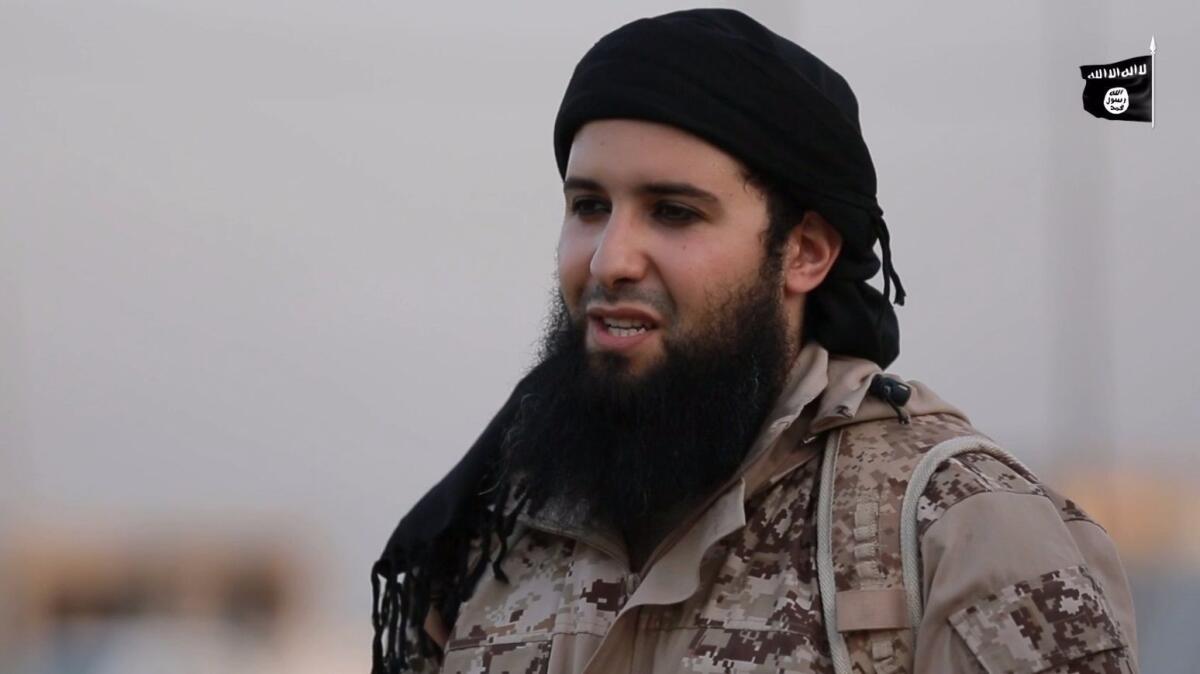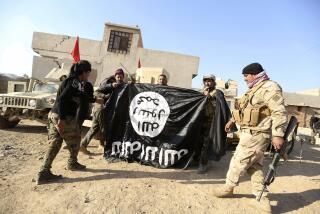The U.S. military is targeting Islamic State’s virtual caliphate by hunting & killing its online operatives one-by-one

- Share via
Reporting from WASHINGTON — The months-long manhunt for French-born Rachid Kassim ended one chilly morning early this year when a drone-launched missile destroyed his battered white pickup truck as it motored through the besieged Iraqi city of Mosul.
The 29-year-old former rapper had cast a grim shadow in international counter-terrorism circles. He spoke fluent French, once beheaded a man in an online video and played a role in a string of terrorist plots — two successful — in France last year.
The Feb. 8 drone strike notched a victory for a U.S.-led effort that seeks to silence Islamic State operatives who use social media, encrypted messaging and other online tools to reach disaffected Muslims overseas and to launch what counter-terrorism experts now call “remote-controlled” attacks.
As Islamic State steadily loses ground in Iraq and Syria, its ability to sponsor and inspire headline-grabbing attacks abroad looms larger than ever — providing the militants the appearance of lethal viability despite the caliphate’s collapsing borders.
In recent weeks, Islamic State has claimed responsibility for killing a policeman on the Champs-Elysees in Paris, for the Palm Sunday bombings of two churches in Egypt, for an attack by gunmen disguised as medical staff that left 38 dead at a hospital in Kabul, Afghanistan, and for a suicide bombing that killed 88 people at a Sufi shrine in southern Pakistan.
The European Union’s police agency, known as Europol, discovered last week that Islamic State has built its own social media platform to try to evade law enforcement and intelligence agencies that monitor the militants’ communications and propaganda, according to Rob Wainwright, head of Europol.
“We have certainly made it a lot harder for them to operate [in digital space], but we’re still seeing these awful videos [and] communications operating large scale across the Internet,” Wainwright said Wednesday at a security conference in London.
Europe is facing “the highest terrorist threat for a generation,” he warned.
European security officials already are bracing for hundreds of foreign militants to return from the battlefields in Iraq and Syria and are scrambling to respond. The State Department issued a travel alert Tuesday for all of Europe because of the threat of terrorist attacks on the continent.
The military defeat of ISIS is essential but not sufficient.
— Gen. Joseph Votel
Gen. Joseph Votel, head of U.S. Central Command, which oversees military operations in the Middle East, acknowledged Islamic State’s loss of territory does not mean it is on the verge of collapse.
The group will continue to coordinate and inspire attacks from its online “virtual caliphate,” he said in an email interview.
“The military defeat of ISIS is essential but not sufficient,” he said, using an acronym for Islamic State. “As we continue to degrade ISIS’ physical capability they will shift more of their attention to the virtual realm and we will need to do whatever we can to stay ahead of them.”
U.S. efforts to counter extremist messaging has largely failed so far, said Thomas Joscelyn, a senior fellow at the nonpartisan Foundation for Defense of Democracies in Washington.
“The U.S. government needs a systematic campaign to undermine the messaging,” he said. “So far any effort to do that has flat out failed.”
A Government Accountability Office study released in April found “no cohesive strategy with measurable outcomes has been established” for counter-propaganda against Islamic State.
“Islamic State’s propaganda will assuredly outlive their physical caliphate,” said Charlie Winter, a research fellow at King’s College in London. “This resilience means their ability to inspire terrorist attacks will also live on.”
Twitter has suspended more than 635,000 accounts linked to Islamic State since 2015. the company says. Facebook, YouTube and other social media companies also regularly remove the militants’ material.
But the group still publishes a monthly online magazine in ten languages, issues messages via its Amaq news agency and posts videos that are widely shared on Twitter, Telegram and elsewhere, U.S. officials say.
Information gleaned from U.S. special operations raids, surveillance drones and informants has enabled analysts to piece together what they believe is Islamic State’s chain of command, including a secretive wing of external operations planners that is assigned to plot attacks in different regions of the world.
A team of U.S. commandos, called the expeditionary targeting force, has killed more than a dozen suspected planners since last summer, according to U.S. officials.
In addition to Kassim, the French-speaking plotter killed by drone, they include Abu Muhammad Adnani, head of external terrorism plots, who was killed by an armed drone Aug. 30.
Eight days later, Abu Mohamed Furqan, who oversaw production of propaganda videos and created the group’s monthly online magazine Rumiyah, was also killed by a drone strike in Raqqah, Islamic State’s self-declared capital in Syria.
In December, another airstrike in Raqqah killed three men said to have played a role in the November 2015 assaults that killed 130 people in Paris. Abdurakhmon Uzbeki, who helped organize the New Year’s Day attack on a nightclub in Istanbul, Turkey, that left 39 dead, was killed in April in eastern Syria.
“ISIS uses information as a weapon, so targeting key people in their messaging operations can be devastating,” Lt. Col. Sean Heidgerken, deputy director of a U.S. military counter-propaganda unit, said in a phone interview from Baghdad. “It’s similar to going after a key general or prominent decision-maker of enemies in past wars.”
Heidgerken’s team drops leaflets, broadcasts radio messages and helps target radio towers, video production facilities and Internet kiosks used by Islamic State.
The militants typically rely on foreign-born operatives to communicate online with sympathizers abroad. They then try to move the conversation to encrypted messaging apps, such as WhatsApp and Telegram, to avoid detection.
“Encryption is the real game changer,” said Alexander Meleagrou-Hitchens, a terrorism expert at George Washington University. “It takes the conversation underground and poses a huge challenge to stopping attacks.”
Kassim used his Telegram channel “Sabre de Lumiere,” or Sword of Light, to communicate with sympathizers in France.
In September, four French women were arrested after they allegedly heeded his directive to “fill a car with gas cylinders, sprinkle petrol in it and park in a busy street ... BOOM,” according to a message that police later said was found on a public Telegram channel.
Their Peugeot, parked near the Notre Dame Cathedral in Paris, failed to explode.
In July, two armed men stormed a church and slit the throat of an 85-year-old Catholic priest during a morning Mass near Normandy in northern France. The killers, who apparently had been in contact with Kassim, were both shot dead.
A month earlier, another supposed Kassim follower killed a French police commander and his partner at their home outside Paris — and reportedly streamed it live on Facebook before he was killed by police.
In July, days after an Islamic State follower mowed down and killed 86 people with a truck in Nice, France, Kassim appeared in a video dressed in a black headscarf and camouflage fatigues. He praised the slaughter, promised more atrocities in France and used a serrated knife to behead an unidentified man kneeling before him.
Twitter: @wjhenn
ALSO:
Climate change is real: Just ask the Pentagon
Trump administration stops disclosing troop deployments in Iraq and Syria
U.S. launches dozens of missiles at Syria in response to chemical weapons attack
More to Read
Sign up for Essential California
The most important California stories and recommendations in your inbox every morning.
You may occasionally receive promotional content from the Los Angeles Times.











